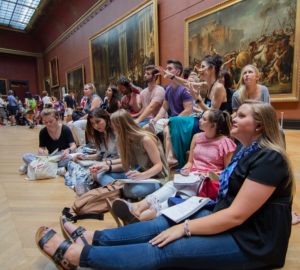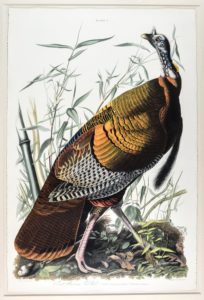The McClung plays a big role in the UT experience for many members of our campus community. To highlight these connections, we asked UT faculty and staff to tell us about an object in our collection that has impacted their classes, their students, or their own exploration within the museum.

Mary Campbell (center, gesturing) teaching a class.
Mary Campbell serves as an Associate Professor of Art History in the School of Art. When asked for a favorite object, she did not hesitate.
“For me,” says Dr. Campbell, “It has to be the John James Audubon print of a wild turkey. I love this print, not only because it’s aesthetically fantastic, but because it ties into so many of the themes that come up as I teach American––and especially colonial and early American––art. The links between natural history and national pride; Charles Willson Peale’s museum; the gendered nature of natural history illustration in the United States; Benjamin Franklin’s belief that the turkey, rather than the eagle, should have been the country’s national animal––it’s all there in that print. I love sending students over to write about it.”
John James Audubon (1785–1851) is one of the world’s most famous ornithologists and natural history illustrators. This print comes from Audubon’s “elephant folio,” in which American birds were illustrated at life size. The McClung has several of these impressive prints, including Audubon’s Wild Turkey, Male. As a result of its size, as Dr. Campbell noted, seeing the turkey in person is incredible. The mastery of detail and texture captured by Audubon’s work is central to his fame as an illustrator.
Regarding Benjamin Franklin’s feelings toward this beautiful animal, the story of his desire to have it as the national bird is a combination of myth and truth. Franklin did feel that the bird was more honorable than the bald eagle––and a better representative of the new United States––but he didn’t specifically suggest it to serve as the national bird. Rather, he wrote to his daughter that the turkey more appropriately embodied the new Republic’s spirit than the bald eagle. Bald eagles are, in part, a scavengers, which according to Franklin, means that they are lazy. As with many things about Mr. Franklin, though, his opinion about turkeys was a little tongue in cheek. He said that, though the turkey is “a Bird of Courage,” they are also “vain and silly.”
It must be hard not to be vain when you are so handsome, though.
Turkeys (genus: Meleagris) are unique to North and Central America. They have a long relationship with indigenous peoples of the Americas, and of course, they have the well-known connection to contemporary food ways in the US. The turkey may not be the national bird for the United States, but there is no doubt that it deserves the admiration bestowed upon it by Mr. Franklin, Dr. Campbell, and so many others.
Inspired to celebrate Audubon’s wild turkey? Check out our embroidery project, #StitchTogether: Spry as a Spring…Turkey.
